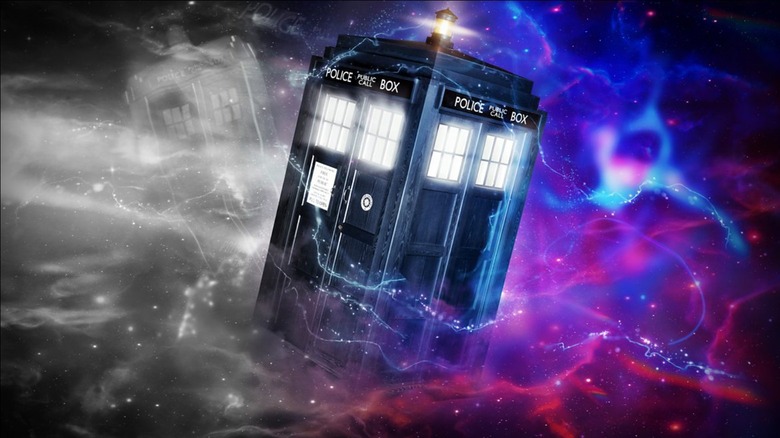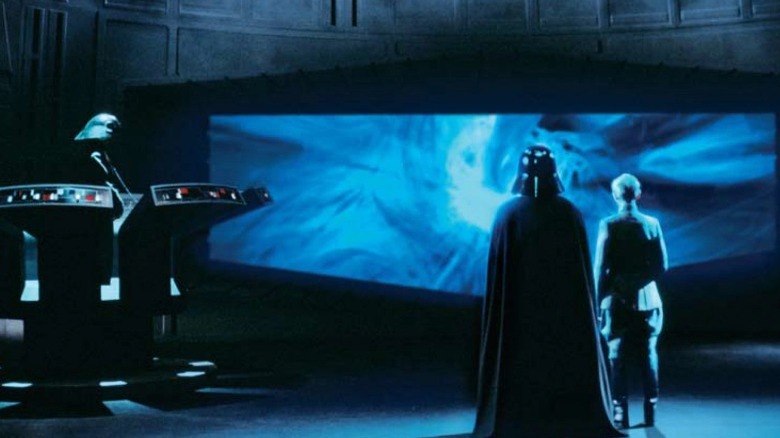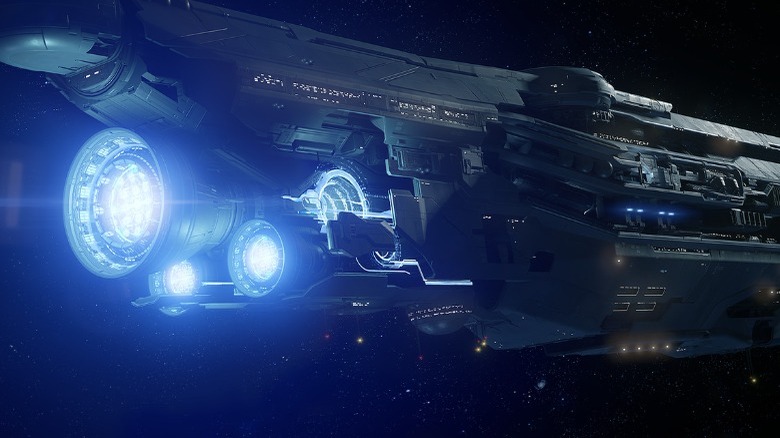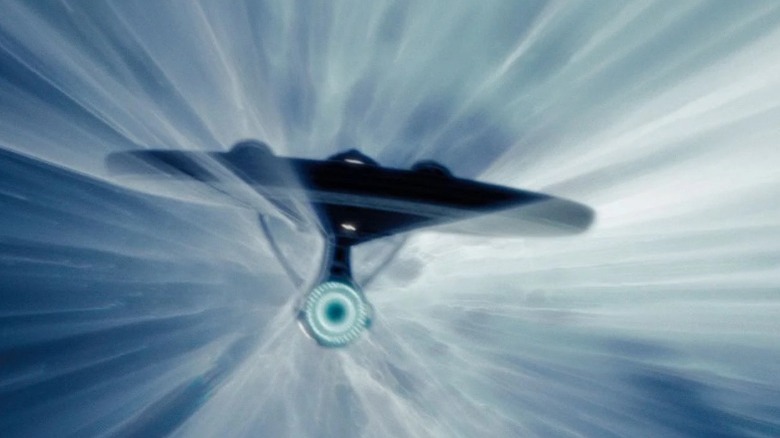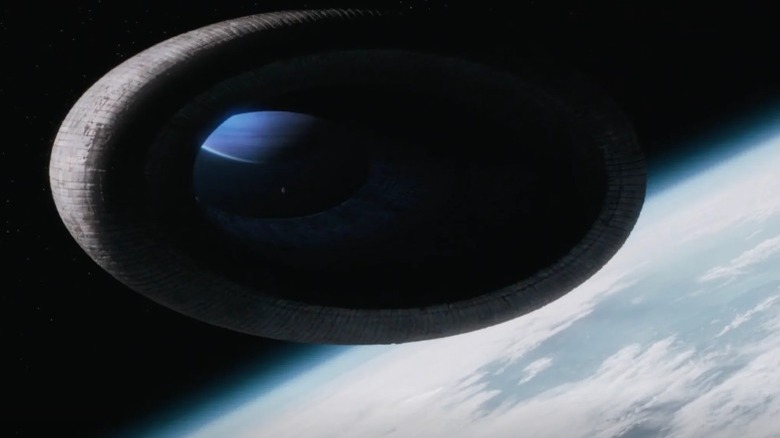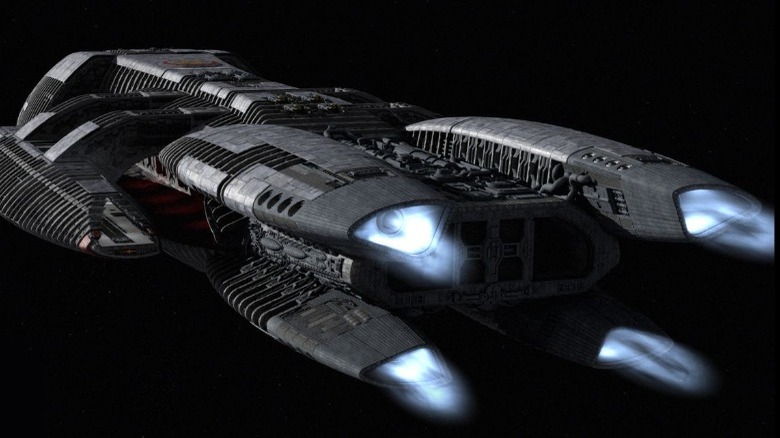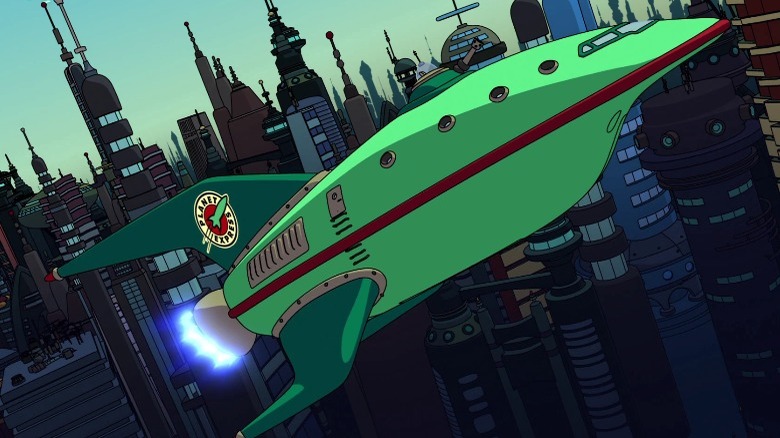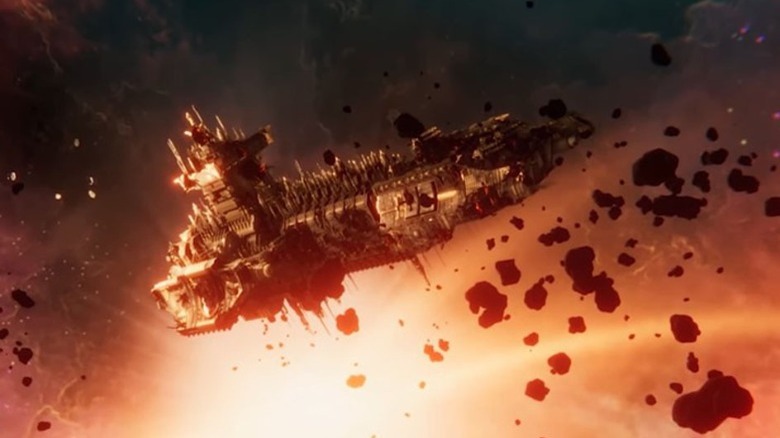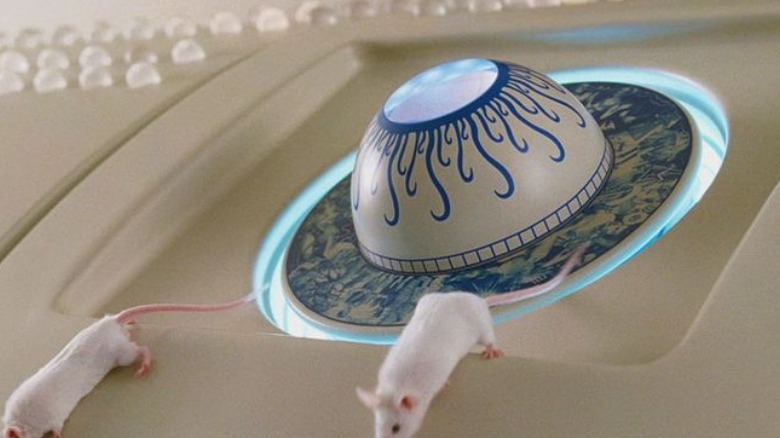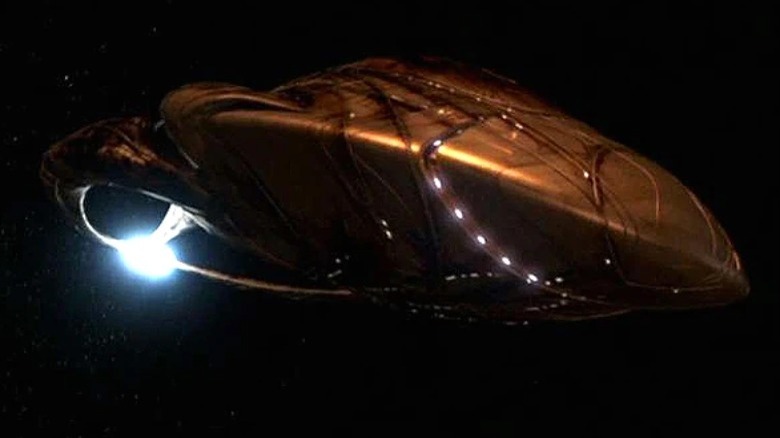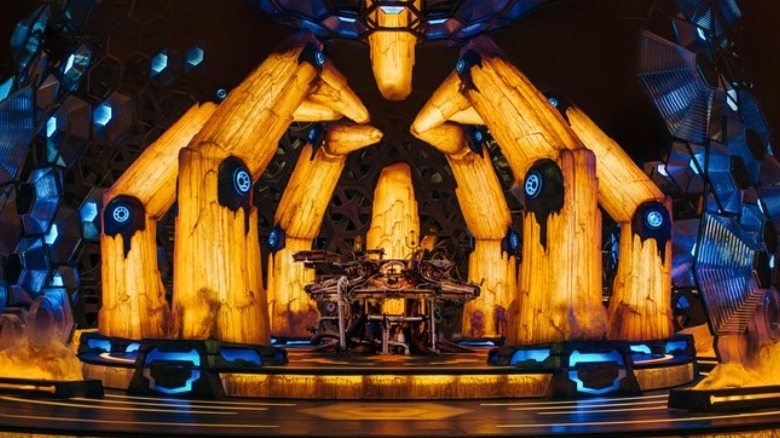10 Of The Most Intense Sci-Fi Engines Ranked By Absurdity
The world of science fiction is filled with countless spaceships, many of which can travel faster than the speed of light. This is a necessary conceit in sci-fi, though it goes against Einstein's speed of light constant, as without faster-than-light travel, it would take humans and aliens alike millennia to travel the vastness of space.
Explaining exactly how these spaceships work and how they can exceed the speed of light is one of the most interesting aspects of fictional sci-fi universes. Writers and filmmakers often lean on something like warp speed, which seems a little more possible these days, but sometimes they come up with something outlandish enough to be inconceivable to real-world engineers and scientists.
These are the most intense engines that have ever shown up in a sci-fi property, all absurd in their own unique ways — some use insane amounts of energy, while others utilize methods of propulsion that are simply preposterous.
10. Death Star Hyperdrive
What makes the Death Star so absurd is its sheer size. No detailed specifications about the space station are given in the original films, but it's clear that the scale of the Death Star was unheard of in the "Star Wars" universe. Characters expressed disbelief at its size, at first mistaking it for a moon.
Thanks to the numerous books and sources of the "Star Wars" expanded universe, we know just how big the Death Star is. The space station features tens of thousands of blaster and ion cannons, tractor beams to pull in enemy ships like the Millennium Falcon, and a full fleet of TIE Fighters. Over a million members of the Empire work on board at any time, including stormtroopers, officers, and Navy personnel, as well as countless engineers and mechanics. In total, the Death Star is some 100 miles wide at its equator. That's equivalent to over 90 Super Star Destroyers in width, ships that are already massive compared to any other spacecraft in "Star Wars."
The Death Star's class 4 hyperdrive is responsible for moving it through space. This allows the immense space station to travel through hyperspace despite its huge weight and size. The engine makes it possible for the Death Star to travel through the alternate dimension at faster-than-light speeds. Meanwhile, the thrusters used to power the Death Star and propel it through normal space give off enough energy to accelerate a 12-mile-wide asteroid at more than 137 meters per second. Some of the sci-fi tech in "Star Wars" has since become real, in a limited way, but we'll probably never see something as absurd as the hyperdrive.
9. Shaw-Fujikawa Translight Engine
The very nature of "Halo" means the video game series is full of spaceships from a range of species. Set in the 26th century, the series focuses on a galactic conflict between humanity and an alien threat known as the Covenant. The Covenant is essentially a religious alliance between several species that worship the technology of the Forerunners — an ancient civilization that once ruled the galaxy but was wiped out in a war with the parasitic Flood. With so many different spacefaring groups in the franchise, it makes sense that there's a diverse range of engines and space travel technology.
UNSC ships are the most well-known and frequently shown, simply because they are humanity's navy. Yet, whether it's UNSC vessels or craft from the Covenant or Forerunners, they all travel through space using the same faster-than-light method. The various ships essentially leave normal space and enter slipstream space — often called slipspace — where the usual laws of physics don't apply. UNSC ships use a drive known as the Shaw-Fujikawa Translight Engine, which punches through normal space and allows a ship to enter slipspace.
Human technology is not as advanced as the Covenant or Forerunner tech. To achieve the same results in terms of propulsion and slipspace travel, UNSC engines are often cruder and far larger than their more sophisticated alien counterparts. The largest UNSC vessels are the Infinity-class supercarriers, which have huge Mark X Macedon/Z-PROTOTYPE #78720HDS slipspace drives that utilize Forerunner technology.
8. Warp Drive
Warp drives are one of the most common types of engine in science fiction. Most of them work similarly and are somewhat based on established scientific principles, even if they are hardly realistic. The warp drive is the engine powering pretty much every vessel in "Star Trek," from the various versions of the Enterprise to Discovery and Voyager. However, it is not the only form of faster-than-light travel in the fictional universe, with other species using methods that include black holes.
"Star Trek" may have predicted several real-life technologies, but the way members of the Federation move around the universe is highly unlikely to be replicated in the real world. The warp drives work by generating plasma in a process that involves consuming both deuterium and antimatter. This produces a vast amount of energy that allows the ship to create a warp bubble and distort space.
In essence, warp drives alter space around the ship to move it. The plasma created in the engines produces the warp bubble, which squeezes space in the direction the ship is moving and causes it to expand behind it. The space warping pushes the ship forward and the most powerful warp drives can exceed the speed of light by a factor of several thousand, meaning it can take just a few days to travel across the galaxy. Keeping those powerful engines working at their full capacity is hard work and ships normally have dedicated officers responsible for their upkeep.
7. Holtzman engine
Space travel in "Dune" is not as prevalent as it is in other science fiction franchises. That's largely because much of the action takes place on the planet Arrakis, and characters rarely travel between worlds. That doesn't mean it doesn't happen, though. The Imperium stretches out across the known universe, with thousands of planets under its control. Set some 20,000 years in the future, the world of "Dune" has some very advanced technology, despite the fact that computers have effectively been abolished.
Ships in this universe make use of something known as the Holtzman Effect to achieve faster-than-light travel. The human vessels are equipped with a Holtzman engine that utilizes a scientific theory about subatomic particles to fold space and time. Rather than moving at intense speeds, the universe itself is manipulated to allow near-instantaneous travel between planets. Using this technology, the members of the Empire can travel quickly around the Known Universe in large Heighliners, keeping the various planets connected in spite of the vast distances between them.
The problem with this form of travel is that it is inherently dangerous. Folding space and time in this way can lead to ships colliding with other bodies or becoming lost. Safely traveling in this method requires the use of the Spacing Guild's artificially mutated pilots known as Guild Navigators. Exposed to large doses of the spice Melange, they possess a limited form of prescience (a kind of precognition) that allows them to plot a path through folded space.
6. FTL Drives
"Battlestar Galactica" is a sci-fi series set at an unknown point in human history where civilization has all but been wiped out by an android race known as the Cylons. With the Twelve Colonies of Kobol destroyed, the last human survivors now live on a fleet of civilian ships led by a lone military vessel — a Battlestar-class craft called the Galactica. The ship acts as a protector to the remaining humans in space as they try to find sanctuary on Earth while facing internal and external threats.
The Battlestar Galactica ship itself, like all other military vessels showcased in the series, uses an FTL drive for journeys over long distances. Little is known about exactly how these FTL drives work outside of the fact that they make use of dimensional travel to instantly jump between different points in space. In that sense, the various ships in the show reach speeds far faster than the speed of light, making the FTL drives incredibly powerful and efficient.
The engines have downsides, though. They require tylium, a rare material, as a power source and the "jumps" have a significant effect on both the ship and its surroundings. Using the FTL drive can fatigue the hull or cause stress fractures, and anything nearby will likely be damaged upon arrival. Each jump also has to be relatively short, due to the complicated calculations, although Cylon ships have access to faster and more advanced computers that allow for longer and more precise jumps.
5. Dark Matter Engine
Out of every show on television, "Futurama" arguably has the most diversity in terms of spacecraft. Other franchises have fairly uniform vessels and ships, with individual factions or species using ships that look and work in the same way. That isn't the case in this sci-fi animated series, where almost every single spaceship shown on screen is customized and personal to the owners. Set a thousand years in the future, the show features dozens of aliens and a universe connected via space travel.
The main ship viewers see is the Planet Express Ship — sometimes known as Old Bessie — the spacecraft of the company where Fry, Leela, Bender, and the rest of the main characters work. At first glance, it appears as a glorified delivery truck, taking parcels to destinations dotted around space. It's small and unassuming compared to many of the other ships shown in "Futurama." Yet, it is arguably the most powerful ship in the entire universe.
The Dark Matter Engine powering the Planet Express Ship makes the small green ship faster than any other. Professor Hubert J. Farnsworth's most important invention allows for traveling anywhere in the universe in just a few days, significantly faster than the speed of light and at 200% fuel efficiency. This is thanks to the fact the drive doesn't actually move the ship but instead shifts the universe around it, getting around the fact that nothing can move faster than the speed of light.
4. Warp Engine
The world of "Warhammer 40K" features a variety of methods for traveling in excess of the speed of light. The Tyranids use a biological ship known as a Narvhal that compresses space to allow faster-than-light travel between large gravitational bodies, while Aeldari technology utilizes a series of portals known as Webways. However, forces like the human Imperium and the Orks use an engine known as a Warp Drive or Warp Engine.
Like all Imperium technology, Warp Drives have an element of organic material called wetware, due to a past war with AI that resulted in outlawing all computer-controlled technology. The engines work by cutting a hole in real space and allowing ships to enter a psychic dimension called the Warp or Immaterium. Once inside this new dimension, ships can travel along the psychic currents and emerge in real space vast distances from where they started. Only the largest ships can carry a Warp Engine as they are so vast.
What makes this form of travel, and the Warp Engine itself, so strange is the nature of the Immaterium. This Warp is a hellish nightmare, home to the forces of the Chaos Gods and filled with psychic energy, existing as a twisted reflection of the real world. Ships can easily be lost in the currents and therefore require Navigators — specially mutated humans — to find a route through the Warp. Because of this, long distances are usually cut down into shorter journeys that are easier and safer to navigate.
3. Infinite Improbability Drive
What began as a science fiction comedy novel by Douglas Adams has evolved into a franchise that includes everything from radio plays to video games and blockbuster movies. "The Hitchhiker's Guide to the Galaxy" takes place in roughly the modern day, where Earth is about to be destroyed by a Vogon Fleet and Arthur Dent becomes embroiled in an adventure across the galaxy with various aliens and beings. He does so aboard the Heart of Gold, a spaceship that Zaphod Beeblebrox steals from the galactic government.
Fitted with the latest technology from the Sirius Cybernetics Corporation, the ship makes use of something called the Infinite Improbability Drive to move around. It's described in the novel as a means of spaceflight that doesn't use hyperspace. Designed specifically for the Heart of Gold, the engine can transport the ship to any location in space instantly. This is achieved through harnessing the power of quantum mechanics and highly improbable events so that everything, whether conceivable or inconceivable, happens at the same time.
Essentially the Infinite Improbability Drive causes itself to be present in every aspect of the universe in the same instant. Once the drive starts to settle and stabilize, the user can determine where they want to appear in space by determining the odds of materializing in that location. Side effects of using such a strange device include turning sperm whales into nuclear warheads and transforming Ford Prefect into a penguin.
2. Starburst
The science fiction television series "Farscape" aired between 1999 and 2003. It follows a group of rebels attempting to evade the authoritarian Peacekeepers in an unknown part of the Milky Way galaxy. In the show, there are two types of ships widely seen. First, there are the mechanical Command Carriers of the alien Peacekeepers, which house the forces of the organization and carry other smaller vessels. And then there are the Leviathans.
Leviathans such as Moya, the ship used by series protagonist John Crichton (Ben Browder) and his companions, are biomechanoid spacecraft. They are not simply mechanical vessels, but living creatures. They bond with a pilot and communicate non-verbally with them as they travel through space. They act like other spacecraft and include all the facilities you'd expect, but each ship is as unique as any living creature, and no two Leviathans have the same build and layout.
These living ships have two forms of propulsion through space. The first is a more conventional form of power known as a hetch drive, which gives them the ability to move at sublight speeds. They also possess something known as Starburst, a faster-than-light system that tears a hole in space-time so that the Leviathan enters a one-dimensional plane where it can move faster relative to normal space-time.
1. TARDIS Engine
Anyone who has seen even a single episode of "Doctor Who" will know that the TARDIS — standing for Time And Relative Dimension In Space — is not your usual spaceship. The craft, which is shaped like an old-fashioned British police phone box due to a broken chameleon circuit, is capable of not just traveling to any location in the universe, but also to any time. The transport of choice for Time Lords combines the features of a spacecraft and time machine into one impressive package.
The TARDIS can travel through both time and space in an almost limitless manner — it is also immensely powerful. Inside, the vehicle is massive and larger than you would think from its exterior. It can also translate languages instantly for its passengers and withstand tremendous forces, from black holes to weapon fire. The aesthetic of the interior also changes from time to time, and you can expect a brand-new look for the new Russel-T.-Davies-helmed season. Perhaps most impressive is the TARDIS's ability to tow objects as large as planets seemingly without any effort.
The TARDIS usually works by disappearing in one spot and then reappearing in another. It does this via the Time Vortex, a dimensional plane that exists outside of time and space and acts as a sort of intersection between them both. The TARDIS's engines are powered by a star that has been artificially converted into a black hole. Known as the Eye of Harmony, it is the energy source for all Gallifreyan technology and makes time travel possible.
